Alternating Push Ups: Benefits, Muscles Worked, and More
Being half-way between performing a full set of push-ups but still needing knee push-ups is a difficult one - should the exerciser perform low-volume push-up sets, or keep doing knee push-ups at a higher intensity?
In truth, the answer is actually both; the alternating push-up is quite literally just a conventional push-up alternated with a conventional knee push-up - providing the benefits of both and acting as a stepping stone between the two exercises.
What are Alternating Push-Ups?
In technical terms, the alternating push-up is a multi-joint compound calisthenic exercise primarily performed as the primary source of upper body training stimulus in a bodyweight workout.
It is particularly unique due to the fact that it is actually two exercises combined into one; the conventional push-up and the knee push-up, both of which are classified as calisthenic pushing exercises known for targeting the chest, arms and shoulders with high volume training stimulus.
Because the alternating push-up is a cross between two exercises, it is also summarily programmed as a high volume exercise, with priority given to the full push-up rather than the knee push-up due to its greater level of resistance per repetition.
As a side note, exercisers should understand the distinction between the alternating push-up and the alternating uneven push-up, with the latter involving one hand being raised so as to make the conventional push-up more difficult.
The alternating uneven push-up is an entirely separate exercise, and is considerably more difficult than alternating push-ups.
What are Knee Push-Ups and Conventional Push-Ups?
Before proceeding further, it’s important to first differentiate what the two exercises that make up alternating push-ups are.
The “knee push-up” is a less intense variation of the conventional push-up where the exerciser’s knees are drawn up, thereby reducing stability requirements and allowing the exerciser to lift less of their own body weight.

The “push-up” is a classic bodyweight exercise where the lifter lies on the floor in a plank position and lowers their torso downwards by bending at the elbows.
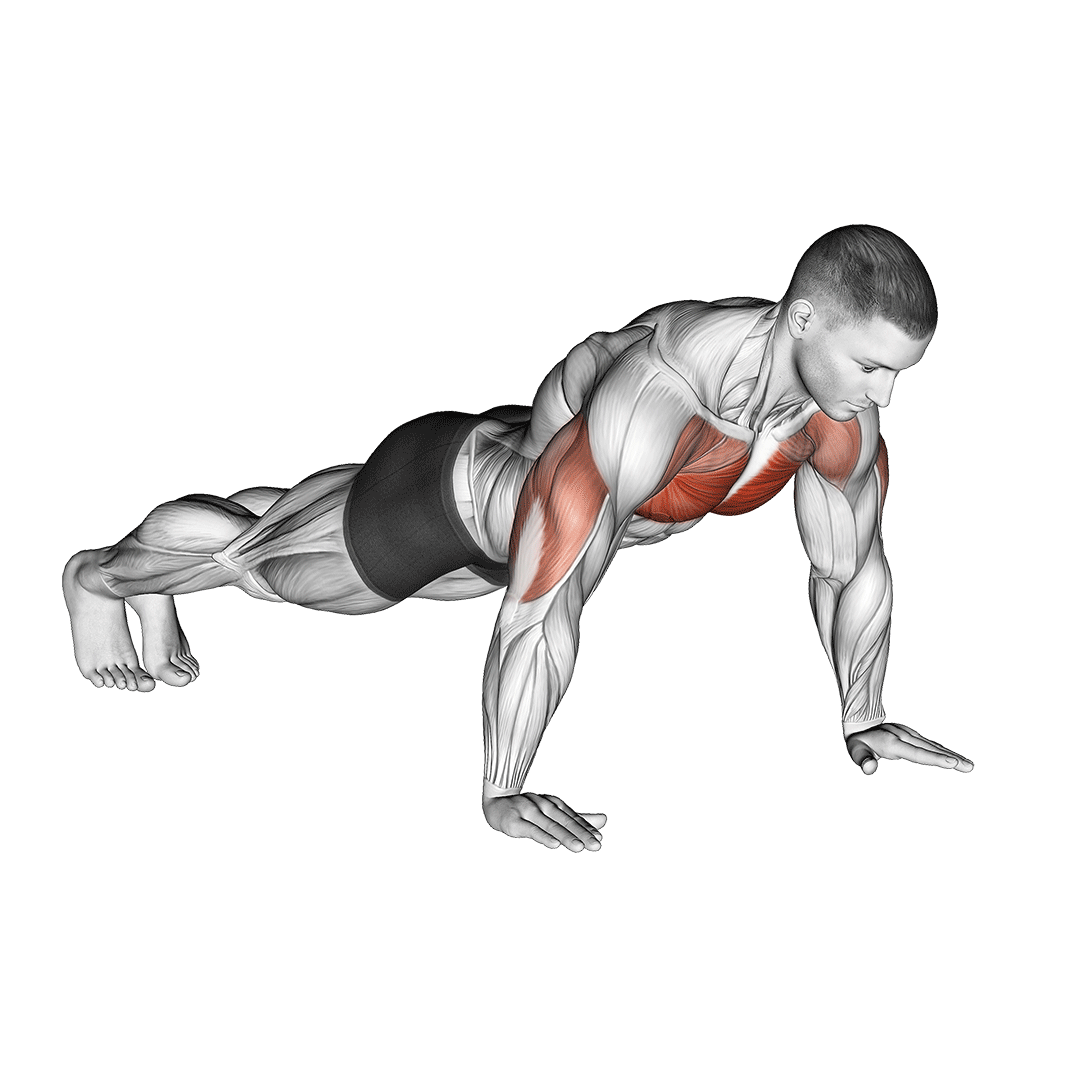
Both exercises act as equipment-free and highly accessible methods of training the muscles of the upper body, with the main difference in their usage being simple difficulty.
Novices unable to perform push-ups will perform knee push-ups.
Who Should Do Alternating Push-Ups?
Alternating push-ups are accessible and relatively simple to perform, and as such are completely suitable for exercisers of all experience levels - provided that they are able to perform a full push-up consistently.
How to do Alternating Push-Ups
To perform a repetition of the alternating push-up, the exerciser will enter a plank position on the floor, with their hands and feet holding their torso aloft and their core contracted so as to make the lower back flat and secure.
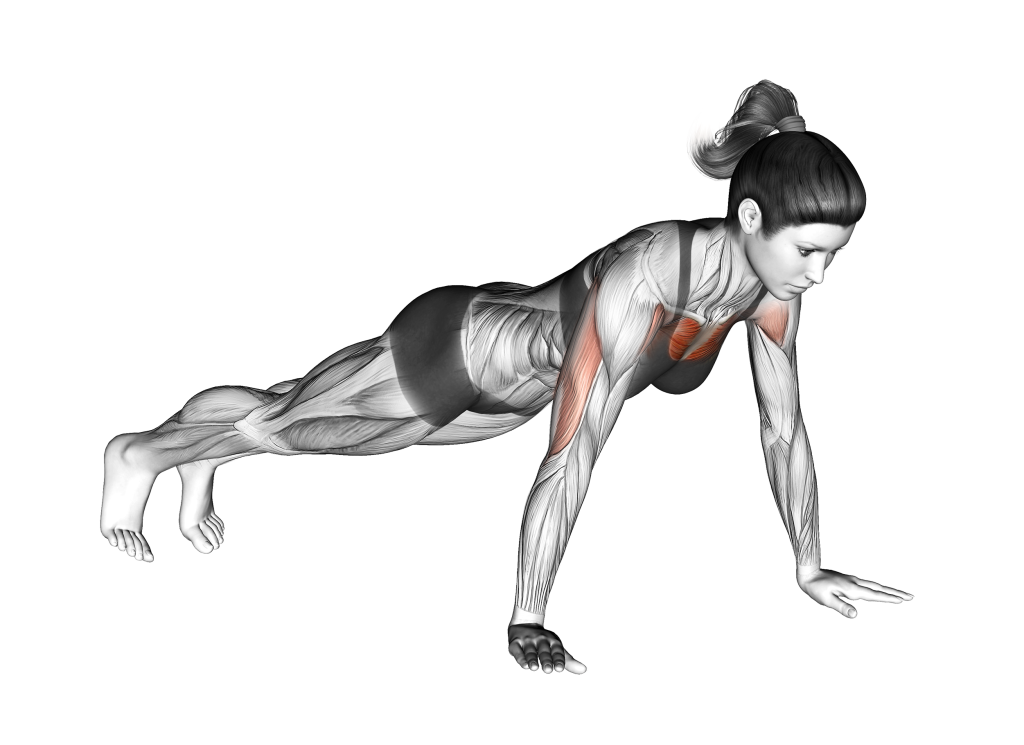
Then, bending at the elbows, the exerciser will lower their chest to the floor, pushing through the palms and once again straightening their arms once the chest is within several inches of touching the ground.
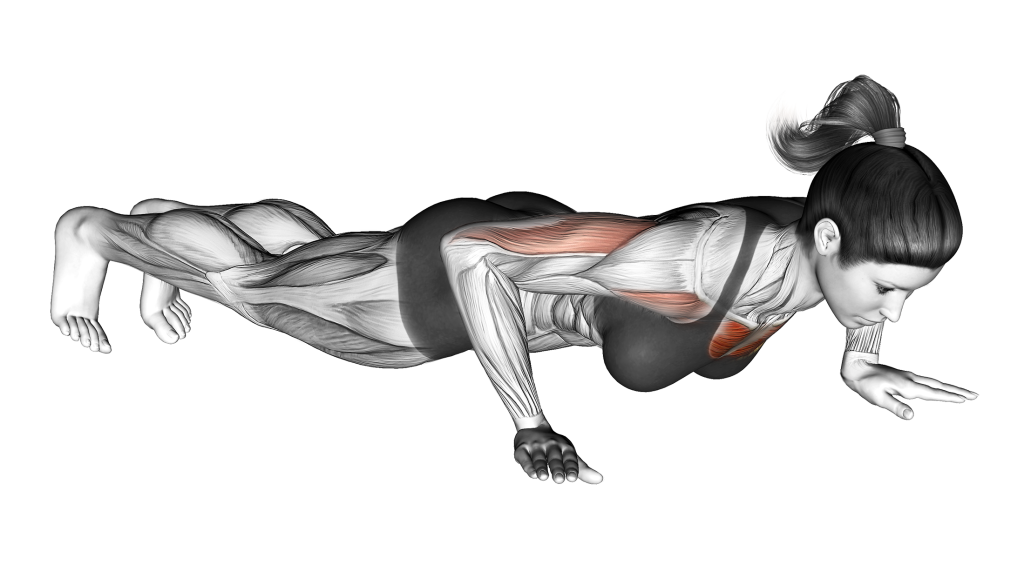
Once the push-up portion of the exercise is complete, they will then follow up with the knee push-up portion by drawing the knees upwards and placing them against the floor so as to better support the torso.
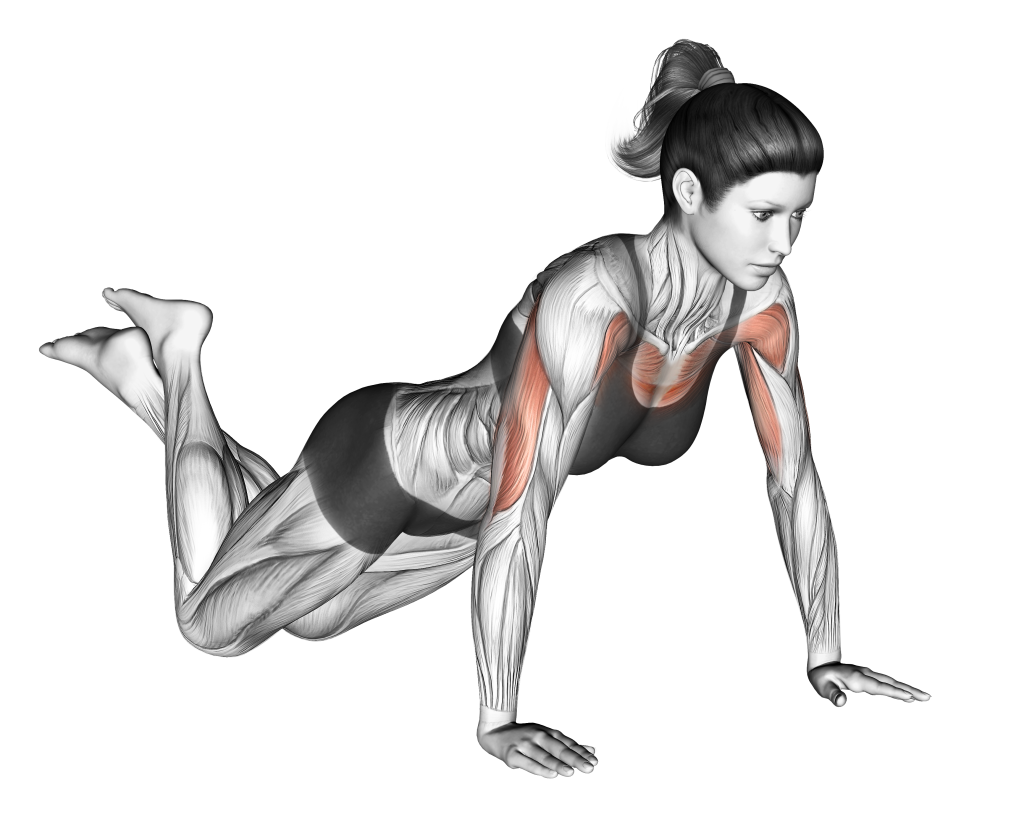
From this position, the lifter will then bend at the arms once more, lowering their chest towards the ground before pushing back upwards, thereby completing the repetition.
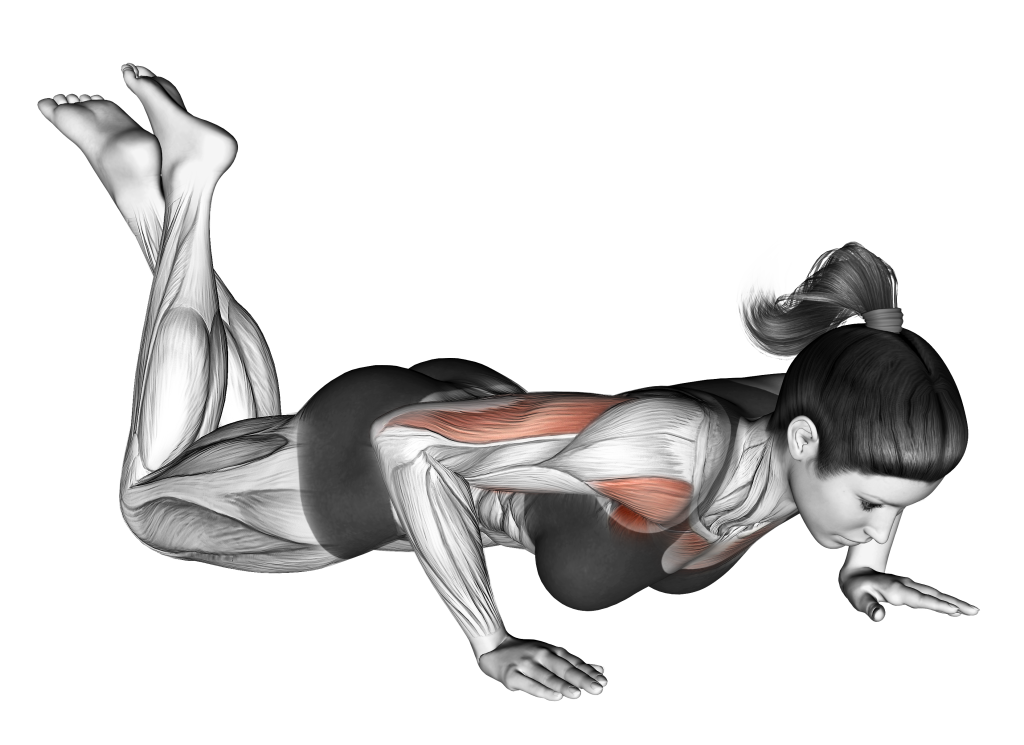
If so desired, both portions of the exercise may be divided into two separate repetitions so as to account for a lesser capacity for volume.
What Muscles do Alternating Push-Ups Work?
Alternating push-ups are a compound movement, meaning that they train more than a single muscle group at once.
Of course, not all of these muscles recruited are utilized to the same extent, and as such are divided into “mover” muscles wherein they are recruited in a dynamic manner, with those trained in an isometric manner being referred to as stabilizers.
Primary Mover Muscles
Regardless of whether the knee push-up portion or the push-up portion, alternating push-ups will train the muscles of the triceps, pectorals and deltoids in a dynamic and highly intense fashion.
Secondary Mover Muscles and Stabilizers
Depending on which portion of the alternating push-up is being performed, the exerciser may use muscles like the serratus anterior and posterior deltoid head as secondary mover muscles.
However, during the push-up portion of the exercise, the glutes, erector spinae and the muscles of the core are used as stabilizing muscles. This is not so much the case with the knee push-up portion, as it is only the abdominal muscles that will play an isometric role.
What are the Benefits of Doing Alternating Push-Ups?
Alternating push-ups are useful in the way that they provide benefits to both novice and advanced exercisers, as they can help build a baseline of strength and technical familiarity while simultaneously helping maximize training volume despite limiting factors like core muscle fatigue.
Excellent for Strengthening the Upper Body
The alternating push-up is particularly useful at training the muscles of the upper body, as it targets many of the largest muscle groups therein with a variable level of intensity and volume.
When combined with other exercises like the pull-up, dip and inverted row, exercisers will be able to achieve a muscular and physically strong upper body without the need for any sort of external source of resistance.
Builds Core Stability In Measured Volume
While the alternating push-up does not quite place the same time under tension on the core as conventional push-ups, they nonetheless allow newer exercisers to train their abdominal, oblique and erector spinae muscles in a measured manner - allowing them to build up the necessary core strength to perform other calisthenic exercises.
For the best core development from alternating push-ups, the exerciser should seek to prioritize the conventional push-up portion of the exercise, and to supplement it with abdominal isolation exercises like planks and leg raises.
Acts as a Progression Step to More Difficult Push-Up Variations
The alternating push-up is unique in its capacity to act as a stepping stone between the knee push-up and the conventional push-up.
Ordinarily, exercisers will transition directly from knee push-ups to full push-ups with no intermediary exercise - a programming move that may be difficult to achieve, as the amount of weight lifted between either exercise can be drastic, depending on the exerciser’s bodyweight.
This is remedied by performing alternating push-ups, of which can allow exercisers to build up the necessary strength and technical skill to perform full push-up sets.
Helps Familiarize Exercisers With Proper Knee Push-Up and Push-Up Mechanics
Because the alternating push-up features two distinct stances, it can be a highly effective tool for drilling the necessary form cues and mechanics of both exercises - all while simultaneously conditioning the exerciser’s body.
This allows the alternating push-up to act as a practice tool for ironing out sticking points or correcting certain push-up execution errors, especially when combined with professional coaching.
Common Mistakes Made During Alternating Push-Ups
Although alternating push-ups are a relatively forgiving exercise as far as mistakes go, there are a few more common errors in execution that must be corrected so as to ensure that they remain a safe and effective training tool within the exerciser’s workout.
Kipping or Utilizing Excessive Momentum
Just as is the case with almost all other exercises, “kipping” or making use of excessive momentum so as to make the exercise easier is one of the most common mistakes one can make when performing alternating push-ups.
In order to prevent injury and ensure that the muscles of the upper body are properly recruited through a full range of motion, each repetition of the alternating push-up should be performed with as slow and controlled a movement as possible.
Allowing the Torso to Sag
Regardless of what sort of push-up variation is being performed, allowing the torso to sag downwards will effectively reduce the exercise’s range of motion and potentially irritate the tissues of the lower back.
A sagging torso during the alternating push-up is generally a sign of poor core musculature contraction, although it could also be due to poor positioning of the pelvis.
In either case, the exerciser should strive to maintain a flat torso that is relatively parallel to the floor, keeping the muscles of the core braced throughout each repetition.
Keeping the Feet on the Floor During the Knee Push-Up Portion
During the knee push-up phase of the alternating push-up, the exerciser may be performing the exercise with their shins or feet still touching the floor, rather than balancing atop the knees.
This can make maintaining a straight torso difficult and negate some of the benefits associated with performing knee push-ups properly and should generally be avoided.
Instead, the exerciser should raise their feet into the air, with the knees making contact with the floor.
When to Use Alternating Push-Ups
Alternating push-ups have two specific use cases, as both of its component exercises surpass it in terms of training intensity and applicability.
The first of these uses is if the exerciser cannot perform a full set of conventional push-ups (as was mentioned earlier), with the second being for more advanced exercisers that can do so, but require more volume than their smaller muscle groups would allow due to fatigue.
For Maximizing Volume
In order to use alternating push-ups to maximize push-up volume, the exerciser must first be limited in their maximum push-up volume by either their abdominals or their legs - both of which are not as much of an issue with alternating push-ups due to the knee push-up interspersed between each regular push-up repetition.
Of course, there is also the fact that the knee push-up is lighter in resistance than the full push-up, also allowing the alternating push-up to be used for greater training volume.
As a Progression to Standard Push-Ups
As mentioned previously in this article, the alternating push-up can as as a progression step between knee push-ups and conventional push-ups - thereby providing a smoother transition that reduces the risk of injury and helps individuals with slow muscular hypertrophy maintain the flow of their progression.
Alternating Push-Up Variations and Alternatives
If the exerciser has already surpassed the alternating push-up - or if they simply wish to try a different exercise - there are quite a number of push-up variations that feature a similar alteration in cadence and stance.
Staggered Push-Ups
Staggered push-ups are simply conventional push-ups performed with the hands set at an askew angle, often with the position of said hands switching between repetitions or sets.
This is done so as to better emphasize one side of the body at a time, allowing for greater loading without necessarily creating the same disadvantages that one-handed push-ups are known for.
As an alternating push-up variation, the staggered push-up is considerably more advanced and is better reserved for exercisers that are seeking a more difficult and specific progression step from the alternating push-up.
Alternating Medicine Ball Push-Ups (or Uneven Push-Ups)
The exercise most often confused for alternating push-ups; uneven push-ups are conventional push-ups performed with one hand elevated through the use of a push-up bar, medicine ball or some other implement.
Raising one hand higher than the other allows for greater resistance to be placed on one arm at a time without causing the lifter to lose balance or create a level of intensity akin to that of a one-handed push-up.
The uneven push-up is more often seen as a progression step from the alternating push-up, as it is considerably more difficult and can allow exercisers to continue the linear flow of their training once alternating push-ups are no longer sufficient.
Alternating Plank Push-Ups
For a more core-focused substitute to the alternating push-up, exercisers may instead switch between a plank exercise and a conventional push-up (rather than a knee push-up), thereby accelerating the rate at which they develop core strength and stability.
Final Thoughts
The alternating push-up is a too-often forgotten exercise that serves a highly effective if not niche role in many bodyweight workouts.
In order to take the greatest advantage of the alternating push-up, it is advised that exercisers seek to transition out of using it as soon as possible - aiming for performing a full set of push-ups and gradually reducing the number of knee push-ups present within the set.
And, as always, it is best to seek out professional coaching if you experience difficulty in any aspect of your training.
References
1. Suprak, David N; Dawes, Jay; Stephenson, Mark D. The Effect of Position on the Percentage of Body Mass Supported During Traditional and Modified Push-up Variants. Journal of Strength and Conditioning Research 25(2):p 497-503, February 2011. | DOI: 10.1519/JSC.0b013e3181bde2cf
